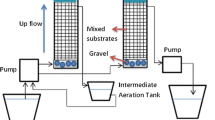Abstract
The prevention of acid mine drainage (AMD) in situ is more attractive than down-gradient treatment alternatives that do not involve source control. AMD source control can be achieved by shifting the microbial activity in the sulfidic rock from pyrite oxidation to anaerobic heterotrophic activity. This is achieved by adding biodegradable organic carbon amendments to the sulfidic rock. This technique was applied to an abandoned coal mine pool in Pennsylvania. The pool had a pH of 3.0 to 3.5. Following treatment, near-neutral pi I and decreased effluent heavy metal concentrations were achieved. In situ bioremediation by the enhancement of bacterial iron and sulfate reduction is a promising technology for AMD prevention.
Similar content being viewed by others
References
Bilgin A.A., and Silverstein, J., 2002, “Role of bacterial iron respiration in in-situ restoration of acid mine drainage,” in Proceedings from the Seventh International Symposium on Environmental Issues and Waste Management In Energy and Mineral Production (SWEMP), Sardinia, Italy, October 7–10, 2002, pp. 737–744.
Bilgin A.A., Silverstein, J., and Hernandez, M., 2005, “Effects of soluble ferri-hydroxide complexes on microbial neutralization of acid mine drainage,” Environmental Science and Technology, Vol. 39, pp.7826–7832.
Bilgin A.A., Silverstein, J., and Jenkins, J. D., 2004, “Iron respiration by Acidiphilium cryptum at pH 5,” FEMS Microbiology Ecology Vol. 49, pp. 137–143. ai Böttcher, M.E., Khim, B.K., Suzuki, A., Gehre, M., Wortmann, U.G., and Brum-sack, H.J., 2004, “Microbial sulfate reduction in deep sediments of the Southwest Pacific (ODP Leg 181, Sites 1119–1125): evidence from stable sulfur isotope fractionation and pore water modeling,” Marine Geology, Vol. 205, pp. 249–260.
Colberg, P.J.S., 1990, “Role of sulfate in microbial transformations of environmental contaminants: chlorinated aromatic compounds,” Geomicrobiology Journal, Vol. 8, pp. 147–165.
Evangelou, V.P., and Zhang, Y.L., 1995, A review: pyrite oxidation mechanisms and acid mine drainage prevention,” Critical Reviews in Environmental Sciences and Technology, Vol. 25, No. 2, pp. 141–199.
Fortin, D., et al., 1995, “Biogeochemical phenomena induced by bacteria within sulfidic mine tailings,” Journal of Industrial Microbiology, Vol. 14, pp. 178–185.
Johnson, D. B., Ghauri, A.M., etal., 1993, “Biogeochemicalcyclingof ironandsulphur in leaching environments,” FEMS Microbiology Reviews, pp. 63–70.
Johnson, D.B., Dziurla, M.-A., et al., 2000, “Novel approaches for bioremedia-tion of acidic, metal rich effluents using indigenous bacteria,” ICARD 5th International Conference on Acid Rock Drainage, Denver, Colorado, Society for Mining, Metallurgy and Exploration, Inc.
Kleinmann, R., 1989, “Acid mine drainage in United States: Controlling the impact on streams and rivers,” in 4th World Congress on the Conservation of Built and Natural Environments, University of Toronto, Toronto, Canada.
Lachmar,., 1994, “Application of fracture-flow hydrogeology to acid mine drainage at Bunker Hill Mine, Kellogg, Idaho,” Journal of Hydrology Vol. 155, pp. 125–149.
Marchand, E.A., and Silverstein, J., 2000, “Remediation of acid rock drainage by inducing biological iron reduction,” ICARD 5th International Conference on Acid rock Drainage, Denver, Colorado, Society for Mining, Metallurgy and Exploration, Inc.
Nordstorm, K.D., and Alpers, C., 1999, “Negative pH, efflorescent mineralogy, and consequences for environmental restoration at the Iron Mountain Superf und site, California,” in Proceedings of the National Academy of Sciences of the United States of America.
Ribet, I., Ptacek, C.J., et al., 1995, “The potential for metal release by reductive dissolution of weathered mine tailings,” Journal of Contaminant Hydrology, Vol. 17, pp. 239–273.
Trudinger, P., Chambers, L., and Smith, J., 1985, “Low-temperature Sulfate reduction- biological versus abiological,” Canadian Journal of Earth Sciences, Vol. 22, pp. 1910–1918.
Villinski, J.E., Saiers, J., and Conklin, M.H., 2003, “The effects of reaction-product formation on the reductive dissolution of MnO2 by Fe(II),” Environmental Science and Technology,” Vol. 37, pp. 5589–5596.
Wielinga, B., Lucy, J.K., etal., 1999, “Microbiologicalandgeochemicalcharacterization off luvially deposited sulfidic mine tailings,” Applied and Environmental Microbiology, Vol. 65, No. 4, pp. 1548–1555.
Author information
Authors and Affiliations
Additional information
Paper number 05-086. Discussion of thiS peer-reviewed and approved paper IS inVited and must be submitted to SME Publications Dept. prior to Feb. 29, 2008.
Rights and permissions
About this article
Cite this article
Bilgin, A.A., Harrington, J.M. & Silverstein, J. Enhancement of bacterial iron and sulfate respiration for in situ bioremediation of acid mine drainage sites: a case study. Mining, Metallurgy & Exploration 24, 139–144 (2007). https://doi.org/10.1007/BF03403208
Received:
Revised:
Accepted:
Published:
Issue Date:
DOI: https://doi.org/10.1007/BF03403208




